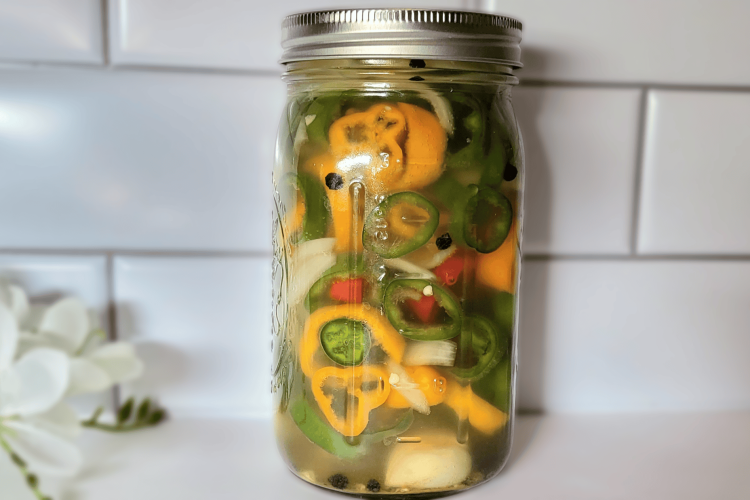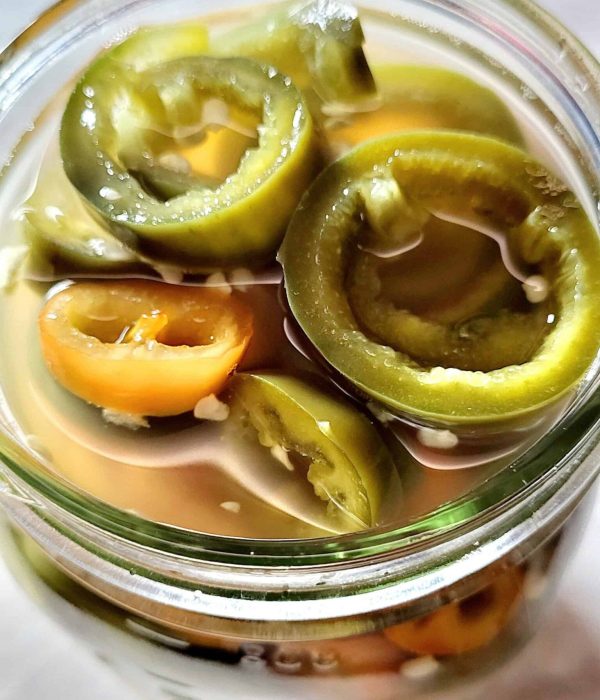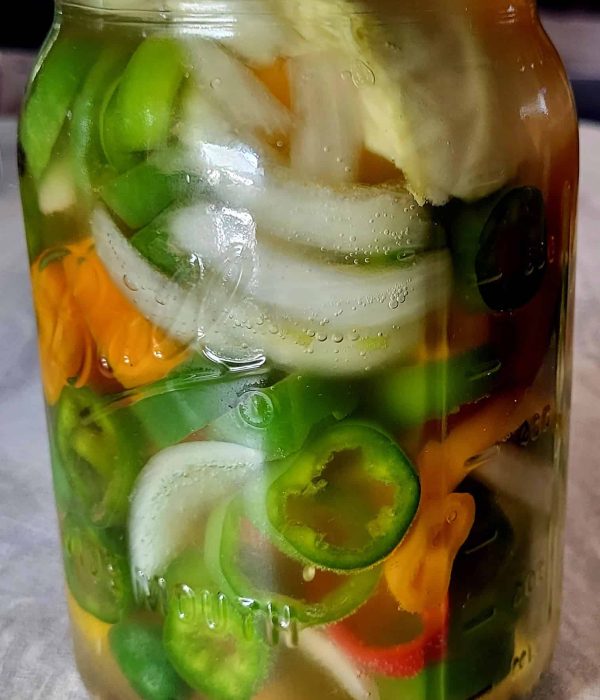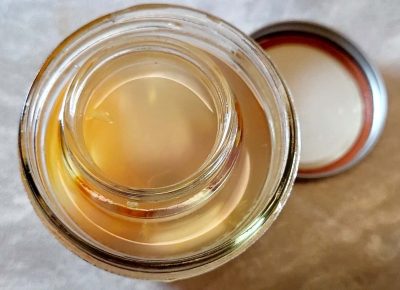Lacto-fermented peppers add a deliciously tangy and flavorful kick to your meals. Best part, they are nutritious and rich in probiotics. In this post, I’ll guide you through the simple steps of creating your own batch of lacto-fermented peppers, sweet or hot (or both). Jalapeño peppers are my daughter and I’s favorite pepper to ferment, and we put them on almost everything. Hope you enjoy them as much as we do!

What are Lacto-Fermented Peppers?
Lacto-fermented peppers are peppers that are naturally preserved by soaking them in a saltwater brine for a period of time. This process allows good bacteria, like Lactobacillus, to grow. The bacteria breaks down the sugars in the peppers and produces lactic acid, which helps preserve the peppers and gives them a nice tangy flavor.
Fermenting this way not only makes the peppers taste great, but it also boosts their probiotic content, which is excellent for your gut. The cool thing is, the longer you let them ferment, the more beneficial bacteria they will contain. Lacto-fermentation is also used to make foods like pickles, kimchi, and sauerkraut.

Are Lacto-Fermented Vegetables Healthy?
Check out my post, Discover the Magic of Fermentation, to learn more about the benefits of lacto-fermentation and the process in general. Fermented foods are great for you, mainly because they’re full of probiotics, which are good bacteria. Our gut naturally has a lot of good bacteria, but when we take in processed foods, medications, antibiotics, alcohol, and become exposed to certain environmental toxins, the good bacteria weakens over time. When that happens, bad bacteria can take over and cause issues. Eating probiotic-rich foods (and drinks like kombucha and water kefir) on a regular basis can help bring back the balance of good bacteria in our gut.

Salt Concentration in Lacto-Fermented Peppers
Salt works double duty here—it keeps the bad bacteria away while giving the good bacteria a chance to multiply. Plus, it helps the peppers stay nice and crisp. I have a recipe you can follow in this post, but if you want to ferment a smaller or larger batch, you can do so by simply following a quick math calculation. I promise, it’s easy and you can bust out your calculator for this (which is what I do, haha)!
You will need 3.5% of the total amount of vegetables + water in grams. To give you an example of what this looks like, let’s say the total weight of your peppers and water is 800 grams. What you’ll do is multiply 800 by 3.5%, which looks like 800 x 0.035 = 28 grams of salt. That’s how much salt you’ll need for your recipe. Let’s say the total weight of peppers and water is 700 grams. In this case it would look like: 700 x 0.035 = 24.5. The easiest and best thing to do here is round up to 25 grams of salt.

How to Make Lacto-Fermented Peppers
Equipment
- Kitchen scale
- Glass mason jar with lid (quart size)
- Fermentation weight (you can purchase them online or use what you already have; ideas below under “Tips”)
Ingredients
- 250 grams organic peppers cut into rings (our favorite is a combo of jalapeño and banana peppers)
- 50 grams onions (sliced)
- 2 garlic cloves (slightly crushed – approx. 20 grams)
- 1 tsp whole peppercorns (whole)
- 480 grams filtered water
- 28 grams sea salt, Kosher, pickling, or Redmond Real Salt.

Instructions
- Wash and dry your glass jar, lid, and fermentation weight. Make sure peppers are also washed.
- Place your jar without the lid on the kitchen scale and select “tare” to zero out the weight (you don’t want to include the weight of the jar, only the vegetables and water).
- Layer the peppers, onions, and garlic into the jar. Add the peppercorns. Pour the filtered water over the vegetables.
- Select “tare” to zero out the weight again, and then add the salt.


- Tighten the lid and shake for about 1 minute to dissolve the salt.
- Remove the lid and place the fermentation weight on top of the peppers, then refasten the lid.

- Place the jar in a cool location away from direct sunlight.
- After a couple of days you should start to see bubbles forming. Once that happens, unscrew the lid to release the natural gasses, and then tighten the lid back up. You’ll want to do this once a day while the bubbling is active. After the first week, the bubbling/gasses will start to slow down. When you no longer see bubbles, you won’t have to continue unscrewing the lid to release the gasses.

- Leave the jar out to ferment for 2-4 weeks. The longer you let it ferment, the more probiotics it’ll contain.
- When your peppers have fermented to your liking, place the jar in the fridge to slow down the fermentation and to store them long term. Although, they don’t last pretty long in my house lol.
Tips and Safety
- Use fresh peppers, and always go for organic if possible.
- Use glass jars and glass fermentation weights, as they won’t react to acids.
- Make sure to use a kitchen scale to weigh your ingredients. This is key because you want to create a setting that encourages good bacteria to grow while keeping the bad ones away.
- Fermentation weights keep the vegetables fully under the brine, which is super important because anything exposed to air can grow mold, ruin the batch, and be unsafe to eat.
- You can purchase fermentation weights online, which are great, but you can also use what you may already have at home. Some ideas would be glass tealight candle holders (without the candles inside), smaller glass containers, a round wedge of cabbage, or even an apple cut in half. Wash and clean them before using. In my photo examples below, I’m using a smaller glass container in the first photo, and a round wedge of cabbage in the second photo as fermentation weights.


- Properly fermented vegetables naturally reach a pH between 4.0 and 3.5, making them tangy, safe to eat, and long-lasting. If you want to be extra precise with the pH levels, you can use pH strips or a digital pH meter to keep track.
- After a few days the brine may start to look cloudy. This is normal and usually means the fermentation process is going well. The cloudiness is usually caused by lactic acid and good bacteria during fermentation. It can also be the vegetables releasing their natural starches and proteins. As long as your ferment smells sour (in a pleasant way), and there are no signs of spoilage, the cloudiness isn’t something to worry about.
- Although rare, if you see mold (fuzzy, black, white, or pink growth) or smell anything foul or rotten, throw the batch away. Also, if the vegetables are slimy, they could be spoiled, so the batch should be thrown out.
- Ferments can last over a year if properly stored, but for best flavor, texture, and probiotic benefits, try to consume within 3-6 months.

Final Thoughts
Making your own lacto-fermented peppers is a fun and healthy way to preserve your homegrown or market-fresh veggies, amp up the flavor, and support your gut. By following these simple steps and letting nature do its thing, you can turn basic ingredients into a tasty, probiotic-packed side dish that’s great for your body. I hope you enjoy the experience!
Disclaimer:
This post is for informational purposes only and is not intended as medical advice. Always consult with a healthcare professional before making any significant changes to your diet, especially if you have existing health conditions.
Other Fermented Recipes you Might Like

Easy and Delicious Lacto-Fermented Peppers Recipe
Equipment
- Kitchen scale
- Glass jar with lid (quart sized)
- Fermentation weight (purchased online or use what you already have; ideas below under recipe notes)
Ingredients
- 250 grams peppers of choice, cut into rings (I like jalapeños with banana peppers)
- 50 grams onions, sliced
- 2 garlic cloves, slightly crushed (approx. 20 grams)
- 1 tsp whole peppercorns
- 480 grams filtered water
- 28 grams non-iodized salt (sea salt, Kosher, pickling)
Instructions
- Wash and dry your glass jar, lid, and fermentation weight. Make sure peppers are also washed.
- Place your jar without the lid on the kitchen scale and select “tare” to zero out the weight (you don’t want to include the weight of the jar, only the vegetables and water).
- Layer the peppers, onions, and garlic into the jar. Add the peppercorns, and then add the filtered water.
- Select “tare” on the scale to zero out the weight again, and then add the salt.
- Tighten the lid and shake for about 1 minute to dissolve the salt.
- Remove the lid and place the fermentation weight on top of the vegetables, and then refasten the lid.
- Place the jar on top of your kitchen counter, cabinet, or pantry, away from direct sunlight.
- After a couple of days you should start to see bubbles forming. Once that happens, unscrew the lid to release the natural gasses, and then tighten the lid back up. You'll want to do this once a day while the bubbling is active. After the first week, the bubbling/gasses will start to slow down. When you no longer see bubbles, you won't have to continue unscrewing the lid to release the gasses.
- Leave the jar out to ferment for 2-4 weeks. The longer you let it ferment, the more probiotics it'll contain.
- When your peppers have fermented to your liking, place the jar in the fridge to slow down the fermentation and to store them long term.
Notes
- Use fresh peppers, and always go for organic if possible.
- Use glass jars and glass fermentation weights, as they won't react to acids.
- Make sure to use a kitchen scale to weigh your ingredients. This is key because you want to create a setting that encourages good bacteria to grow while keeping the bad ones away.
- Fermentation weights keep the vegetables fully under the brine, which is super important because anything exposed to air can grow mold, ruin the batch, and be unsafe to eat.
- You can purchase fermentation weights online, which are great, but you can also use what you may already have at home. Some ideas would be glass tealight candle holders (without the candles inside), smaller glass containers, a round wedge of cabbage, or even an apple cut in half. Wash and clean them before using.
- See post for more tips and safety information.










What an insightful article! I found the information super helpful, especially in today’s world
where maintaining good health is more important than ever.
You’ve done a great job explaining it all clearly (just had to say
that!). I’ll be referencing this post on my
own blog, where I write about diets and nutrition, so others can benefit from your excellent advice.
Appreciate your insights
Thank you for your kind words and for the support!